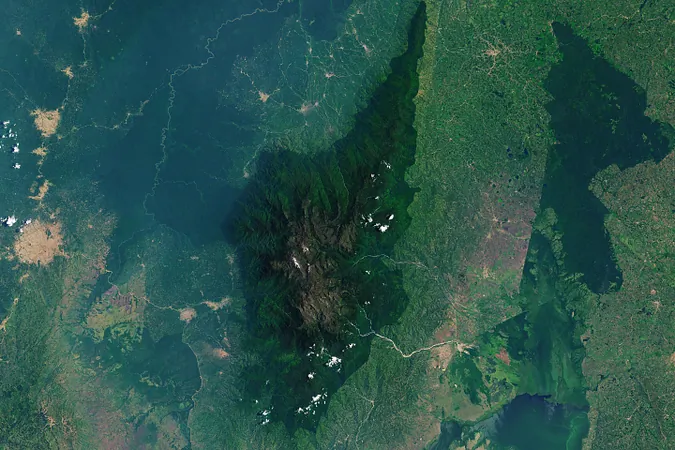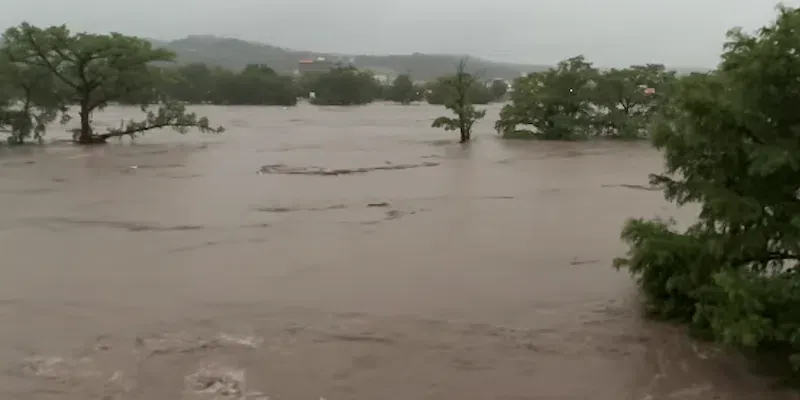
Unlocking the Secrets of the Rwenzori: Africa's Enigmatic 'Mountains of the Moon'
2025-05-16
Author: Amelia
Unveiling the Mystique of the Rwenzori Mountains
Towering majestically over 5,000 meters (16,000 feet) above sea level, the Rwenzori Mountains are a breathtaking spectacle in eastern Africa, often hidden beneath clouds and mist but visible from afar, including space! This stunning range straddles the border between Uganda and the Democratic Republic of the Congo (DRC), forming a spectacular backdrop that captivates adventurers and researchers alike.
A Rare Glimpse: Cloud-Free Views from Space
Captured by the Operational Land Imager-2 (OLI-2) on Landsat 9 on March 13, 2024, a remarkable image showcases the Rwenzori Mountains in one of the clearest views we've seen in years, revealing their natural beauty in a vibrant palette of colors.
The Geological Wonder of the East African Rift
The Rwenzori Mountains are not volcanic, unlike their eastern counterparts, Kilimanjaro and Mount Kenya, which are products of volcanic activity. Instead, they emerged from a unique geological phenomenon caused by tectonic plates pulling apart in the East African Rift Valley, leading to their breathtaking elevation.
A Paradise for Endemic Flora and Fauna
Designated as a national park in 1991 and secured as a UNESCO World Heritage Site in 1994, the Rwenzori Mountains boast a treasure trove of unique plant life, housing endemic species like the towering giant lobelias and rare groundsels. They are also a sanctuary for diverse wildlife, including the elusive African forest elephant, the eastern chimpanzee, and the charming Rwenzori duikers, making this region a biological goldmine.
The Ancient Understanding of the Peaks: The True Source of the Nile?
In the 2nd century CE, the renowned astronomer Ptolemy dubbed these peaks the 'Mountains of the Moon', mythically believed to be the source of the Nile River. While the Nile is fed by a complex network of rivers, the Rwenzori still play a crucial role in supplying water vital to Uganda and DRC. Streams from these mountains nurture rivers like the Semliki and the Nyamwamba, which ultimately flow into significant lakes.
A Cry for the Glaciers: Warming Threatens Their Existence
Not only do the Rwenzori house rich biodiversity, but they also contain a significant portion of East Africa's tropical glaciers. Unfortunately, these icy wonders are in rapid decline; researchers found that the Stanley Plateau glacier shrank by 29.5% between 2020 and 2024, while Mount Speke has lost its glacial cover altogether. As temperatures rise, the future of these glaciers hangs precariously in the balance.
A Worldwide Crisis: The Fate of Tropical Glaciers
Similar catastrophic declines of glaciers are occurring across the tropics—not only in the Rwenzori Mountains but also on iconic peaks like Kilimanjaro in Tanzania and Puncak Jaya in Indonesia. These changes signify a worryingly warming planet, where even the highest elevations struggle to maintain glacial existence.
The Rwenzori Mountains stand as a symbol of nature's splendor and fragility, revealing once again that we must cherish and protect these extraordinary landscapes before they disappear forever.









 Brasil (PT)
Brasil (PT)
 Canada (EN)
Canada (EN)
 Chile (ES)
Chile (ES)
 Česko (CS)
Česko (CS)
 대한민국 (KO)
대한민국 (KO)
 España (ES)
España (ES)
 France (FR)
France (FR)
 Hong Kong (EN)
Hong Kong (EN)
 Italia (IT)
Italia (IT)
 日本 (JA)
日本 (JA)
 Magyarország (HU)
Magyarország (HU)
 Norge (NO)
Norge (NO)
 Polska (PL)
Polska (PL)
 Schweiz (DE)
Schweiz (DE)
 Singapore (EN)
Singapore (EN)
 Sverige (SV)
Sverige (SV)
 Suomi (FI)
Suomi (FI)
 Türkiye (TR)
Türkiye (TR)
 الإمارات العربية المتحدة (AR)
الإمارات العربية المتحدة (AR)